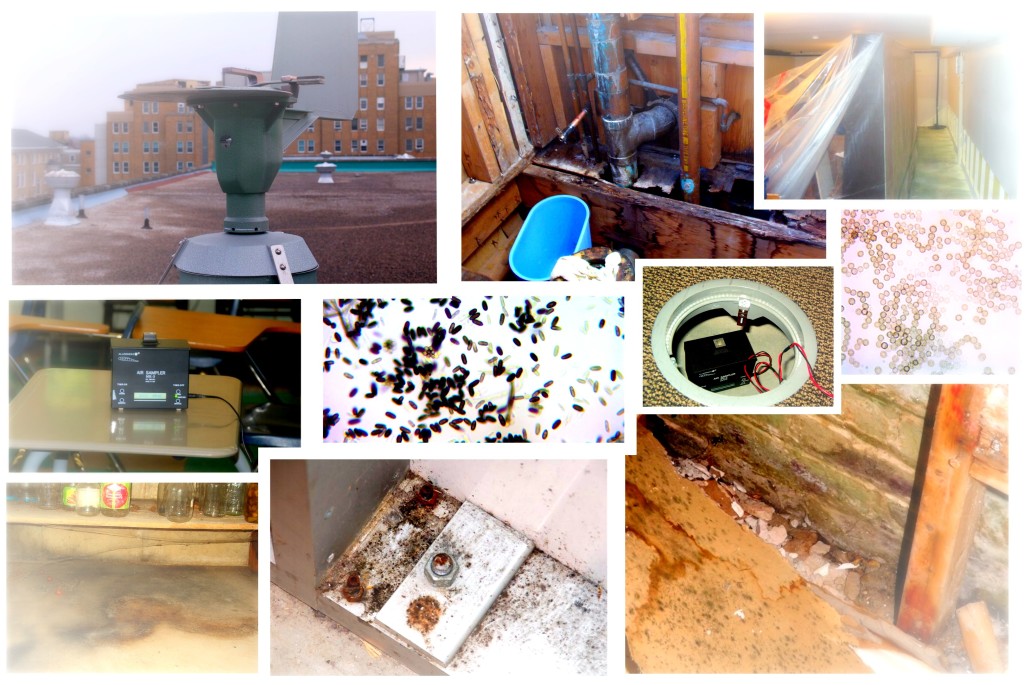Mold is a mystery to many, a misery to others. A short description of issues and facts related to mold exposures in homes, schools and office buildings is presented below. After reading, if you still require assistance with any of these services please contact us.
TOXIC MOLD*
“Toxic” molds that grow in homes, schools, offices & other indoor living spaces
The term “toxic mold” is NOT accurate. Molds are neither toxic, nor poisonous, but some produce mycotoxins. A little mold is found everywhere – in clear air and on many surfaces. The common health concerns from molds include hay fever-like allergy symptoms. Only certain individuals with pre-existing lung disease or immune system disorders are at increased risk of infection from molds.
Common and “less common” molds in buildings
Molds are very common in buildings and homes. They will grow anywhere indoors where there is moisture. The most common indoor molds are Cladosporium, Penicillium, Aspergillus, and Alternaria. The term “toxic black mold” has come to be associated with a type of mold known as Stachybotrys*. While “Stachy” is less common than other mold species, it is not rare. Stachybotrys chartarum (also known Stachybotrys atra) is a greenish-black mold. It likes to grow on material high in cellulose and low in nitrogen content, such as fiberboard, gypsum board, paper, dust, and lint. It grows when there is water damage, excessive humidity, water leaks, condensation, water infiltration, or flooding and requires constant moisture. Stachybotrys, should be treated like all other molds with respect to potential health risks and removal.
How molds get inside and how they grow
Mold spores enter the home or building from outside through open doorways, windows, air intakes for heating, ventilation, and A/C systems. Spores also attach themselves to clothing, shoes, bags, and pets using them as convenient transport vehicles to get indoors. When mold spores drop near a moisture source, they start to grow using the building materials as nutrients. Wet cellulose materials, including paper, cardboard, ceiling tiles, and wood, are particularly good for mold growth, but other materials such as dust, paints, wallpaper, insulation materials, drywall, carpet, fabric, and upholstery are also good.
People at risk from exposure to mold
Most people are NOT at risk. People with allergies may be more sensitive to molds. People with immune suppression or underlying lung disease are more susceptible to fungal infections.
How do you know if you have a mold problem?
Large mold infestations can usually be seen or smelled or there are other indicators related to significant disrepair, deterioration or maintenance of the building. Some people express concerns about “hidden” mold ie. threats from mold they can’t see. It is possible for mold to be growing behind a wall, because of a plumbing leak for example. This is a problem for the building, more so than the occupants, as the condition will continue to deteriorate. The wall acts as a barrier against exposure to mold spores.
What are the potential health effects of mold in buildings and homes?
Mold exposure does not always present a health problem even if detected indoors. Some people are sensitive to molds, most are not. They can experience nasal symptoms, eye irritation, wheezing, or skin irritation when exposed to molds. Some people may have more severe reactions to molds, but this is rare. Severe reactions typically occur among workers who are exposed to large amounts of molds, such as farmers working around moldy hay. Severe reactions may include fever & shortness of breath. Immunocompromised persons & others with chronic lung diseases like COPD are at increased risk for opportunistic infections. They may develop fungal lung infections.
How do you get rid of molds from homes, schools, and inside of buildings?
In most cases mold can be removed from hard surfaces by cleaning with commercial products (biocide), soap and water, or a mild bleach solution (max. 1 cup bleach in 1 gallon of water). For absorbent or porous materials like ceiling tiles, drywall, and carpet it’s easier to throw them away when they become moldy. If extensive, you may want to contact a restoration professional who has experience in mold cleaning and removal. It is important to properly clean and dry the area. Individuals who are truly allergic can react to mold fragments and mold contamination may recur if there is still moisture.
If you use bleach to clean up mold:
- Do NOT mix bleach with ammonia. Mixing them will produce nasty fumes. Follow manufacturer’s instructions when using bleach or any other cleaning product.
- Open windows and doors to provide fresh air.
- Wear non-porous gloves and protective eye wear.
- If the area is more than 10 ft2 consult the U.S. Environmental Protection Agency (EPA) guide entitled “Mold Remediation in Schools and Commercial Buildings” found at https://www.epa.gov/mold/pdf-version-checklist-mold-remediation-mold-remediation-schools-and-commercial-buildings or the “Mold Guidelines for the Canadian Construction Industry” found on that website at www.cca-acc.com/documents/cca82/cca82.pdf
What should people to do if they determine they have Stachybotrys chartarum (Stachybotrys atra) in their buildings or homes?
Mold growing in homes and buildings, whether it is Stachybotrys chartarum (Stachybotrys atra) or other type of mold, indicates that there is a problem with water or moisture. This is the first issue to be addressed. Mold growth can be removed from hard surfaces with commercial products, soap and water, or a mild bleach solution (max. 1 cup bleach in 1 gallon of water). Mold in or under carpets typically requires removal of the carpets. Once mold starts to grow in insulation or on wallboard, remove, cutout and/or replace. The precautions for dealing with “Stachy” are the same as for other molds. After a flood dry the areas promptly and initiate cleaning of walls and other flood-damaged items as necessary. If a home has been flooded, be aware that it also may be contaminated with sewage.
How do you keep mold out of buildings and homes?
As part of routine building maintenance, inspections should look for evidence of water damage and visible mold. The conditions causing mold (such as water leaks, condensation, infiltration, or flooding) should be corrected to prevent mold from growing.
Specific Recommendations:
- Keep humidity level in house between 40% and 60%.
- Use A/C or dehumidifier during humid months.
- Be sure the home has adequate ventilation, including exhaust fans in kitchen and bathrooms.
- Mold inhibitors can be added to paints.
- Bathrooms can be cleaned with anti-microbial products.
- Do not carpet bathrooms.
- Remove and replace flooded carpets.
I found mold growing in my home; how do I test the mold?
Generally, it is not necessary to identify the species of mold growing in a residence, and CDC does not recommend routine sampling for molds. Current evidence indicates that allergies are the type of diseases most often associated with molds. Since the reaction of individuals can vary greatly either because of the person’s susceptibility or type and amount of mold present, sampling and culturing are not reliable in determining your health risk. IF you are susceptible to mold and see or smell mold, there is a potential health risk to you; no matter what type of mold is present it would be best to have it removed. Furthermore, reliable sampling for mold can be expensive; standards for judging what is and is not an acceptable or tolerable quantity of mold have not been established.
Excerpts from CDC and other source

